Shep Hyken's Blog, page 135
December 20, 2018
Best Customer Service and Experience Articles, Videos, & Podcasts
Articles, Videos & Podcasts from 2018
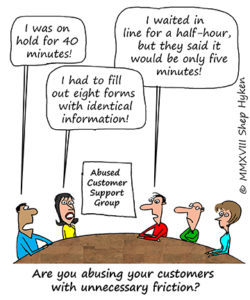
Top Cartoon for 2018
Top 5 Articles to Share With Your Team:
Five Customer Service Must-Do’s For 2018
A business must keep up with the times. If they don’t, they will be disrupted and find themselves either playing catch up or worse, shutting down altogether.
“That’s Not My Department” and 10 Other Phrases Customers Hate
Since customer service has become a center of attention for most companies “That’s not my department” is being heard less and less. That said, there are still plenty of other phrases and words we, as customers, hate to hear.
Treat Your Current Customers Better than Your New Customers
A company wants to acquire new customers and is willing to cut its rates to do so. But, how do you think a customer feels when we see the deal, then calls the company to ask for the same deal, and is told that it’s just for new customers?
For a Successful CX You Must Have a Successful EX
A successful customer experience strategy is a result of the company’s culture. In other words, what’s happening on the inside of the company is going to felt on the outside of the company by the customer.
Three C’s of Customer Service Success
If there is something that is a non-negotiable to creating customer loyalty, it is a consistent and predictable experience – one that customers can count on every time they do business with you.
Share These 3 Videos at Your Next Meetings:
Top 10 Phrases to Avoid in Customer Service
Since customer service has become a center of attention for most companies (even though some still don’t get it right), “That’s not my department” is being heard less and less. That said, there are still plenty of other phrases and words we, as customers, hate to hear. Here’s ten more. (Note: This video is based on an article above, “That’s Not My Department” and 10 Other Phrases Customers Hate.)
Solve the Complaint, Don’t Make an Excuse
The last thing your customer wants is an excuse. Keep in mind that when a customer says anything negative about your product or service, don’t just listen – take action!
How to Stay Competitive
A business must keep up with the times. If they don’t, they will be disrupted and find themselves either playing catch up or worse, shutting down altogether. Embrace the changing expectations of your customer.
Listen to Shep’s Top 3 Podcast Episodes:
When Virtual Reality Becomes Your Customer’s Reality Featuring Guest Jeff Day
Jeff shares ways on how you can utilize virtual reality technology to enhance the customer’s experience.
The Smallest Things Can Make the Biggest Difference to Your Customers Featuring Guest Chris Smoje
Chris shares the DIME Customer Service approach, the four stages of service, and the five values of a service-focused team. He shares how the smallest actions can make the greatest impact on your customers.
The “Magic” Behind the Words You Use Featuring Guest Tim David
What if you knew the “Magic Words” to use with your customers? They discuss the impact that words have on human connection and customer service.
Don’t Miss Out on Shep’s Top 3 Forbes Articles:
Four Habits Of Highly Ineffective Companies
Create a game-changing experience for your customers, and in the process, make your competition irrelevant.
Give A Valuable Gift: The Top 10 Business Books For 2018
Each year I read about 40 books. I peruse dozens of others. I’ll admit I have a bias toward books that focus on customer service and CX, but you’ll still find a few more general business books in this roundup.
Google Introduces Lifelike AI Experience With Google Duplex
Imagine having an intelligent conversation with a computer. Imagine that the computer doesn’t need to repeat things back to you or ask you to confirm what you just said or asked. That it responds in a voice that doesn’t sound like a robot.
Shep Hyken is a customer service expert, keynote speaker, and New York Times bestselling business author. For information, contact 314-692-2200 or www.hyken.com. For information on The Customer Focus customer service training programs, go to www.thecustomerfocus.com. Follow on Twitter: @Hyken
customer service training programs, go to www.thecustomerfocus.com. Follow on Twitter: @Hyken
(Copyright © MMXVIII, Shep Hyken)
The post Best Customer Service and Experience Articles, Videos, & Podcasts appeared first on Shep Hyken.
December 19, 2018
Do Your Customers Trust You This Much?
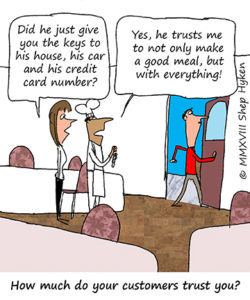 Some of you may or may not know that I perform magic. Not real magic. When I was a kid I did birthday party magic shows, and in high-school and college worked in comedy clubs doing comedy and magic. I still practice card tricks.
Some of you may or may not know that I perform magic. Not real magic. When I was a kid I did birthday party magic shows, and in high-school and college worked in comedy clubs doing comedy and magic. I still practice card tricks.
There was a magic shop in Washington, DC owned by Al Cohen. I met Al when I was a teenager. As I started to perform more and more for money, I could afford to be a regular customer of Al’s. Whether I bought tricks from his newsletter or came to the shop in person whenever I was in town, Al would consider me one of his “regulars.” One day Al said, “Shep, I know what you like. I get new magic books and props in here every week. If you want, I can take your credit card number and send you whatever I know you’ll want. If I’m wrong, send it back.”
Without hesitating, I handed over my credit card info. Every so often I would receive a package from Al’s shop. He was never wrong. Not once did I return an item. He knew me so well – and treated me so well – that I trusted him.
About ten years ago I had a little convertible. I bought it on eBay for a few thousand dollars. I referred to it as my “hunk of junk.” It was fun to drive, and it was mechanically sound. The car was 35 years old, and most regular car dealers wouldn’t work on it because of its age and the difficulty to source parts. I found a mechanic who had one bay in an industrial area and knew how to work on these older cars. I remember taking my car in for service and asking him, “What’s this going to cost me?” He replied with a smile, “Half of what the dealer charges. You’ll have to trust me.” Well, I did, and he never disappointed me. Whenever he worked on my car, it was always less than I thought it would be, and I’m sure at least half of what a typical dealer would charge. I’m glad I trusted him.
Not long ago I had dinner at one of my favorite restaurants. The owner asked if I trusted him to surprise me with a meal that he knew I would enjoy. I reminded him I didn’t like mushrooms. He prepared an amazing meal. It wasn’t on the menu. I had to trust him, and he didn’t disappoint. I can’t wait to go back and trust him again.
These are simple examples just to make the point. It doesn’t matter what type of business you are in, trust creates loyalty. Earning your customers’ trust typically takes time. It comes from a predictable and consistent set of experiences. Your customers know what to expect, and you deliver every time. They also know you won’t take advantage of them. So, how much do your customers trust you?
Shep Hyken is a customer service expert, keynote speaker, and New York Times bestselling business author. For information, contact 314-692-2200 or www.hyken.com. For information on The Customer Focus customer service training programs, go to www.thecustomerfocus.com. Follow on Twitter: @Hyken
customer service training programs, go to www.thecustomerfocus.com. Follow on Twitter: @Hyken
(Copyright © MMXVIII, Shep Hyken)

The post Do Your Customers Trust You This Much? appeared first on Shep Hyken.
December 18, 2018
Amazing Business Radio: Dr. Willie Jolley
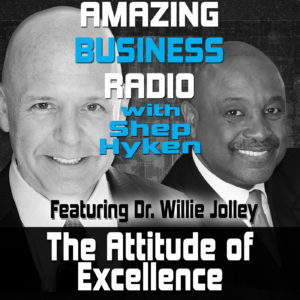
The Attitude of Excellence
Growing Your Organization to Deliver Superior Customer Service
Shep Hyken sits down with his longtime friend, Dr. Willie Jolley and discuss the strategies he used to help Ford avoid bankruptcy, why you and your organization should be constantly improving, and the 10 Commandments of Superior Service.








Top Takeaways:
•Dr. Jolley shared five key points great CEO’s focus on in their organizations:
Always develop leaders at every level of your organization.
Help people understand change is not the enemy, it’s an ally.
Don’t have good customer service, have wild customer service.
Think like a team and work as a team so you can win like a team.
Always grow your attitude and constantly get better.
•In his book, Make Love, Make Money, Make It Last!, he talks about keeping the romance alive in your marriage. You should treat your customers the same way by always wooing them and keeping the romance alive by going the extra mile.
•Dr. Jolley has 10 commandments of superior service:
Thou shalt serve with a smile
Thou shalt go the extra mile
Thou shalt greet, speak and be real sweet
Thou shalt say thank you and please a lot – A LOT
Thou shalt be willing to apologize quickly
Thou shalt anticipate the needs of your customers and clients
Do what is necessary, not what is comfortable
Thou shalt take responsibility
Thou shalt lighten the lines
Thou shalt constantly improve and practice the CANEI principle.
•The CANEI principle stands for Constant And Never Ending Improvement. Everyone in an organization must adopt an attitude in which they strive to be better today than yesterday.
•In his book, Dr. Jolley shares his philosophy of Up-Thinking, which means: Think up, show up, stand up, step up, and make up your mind to win.
Quotes:
“A setback is a setup for a comeback.” – Dr. Willie Jolley
“Always woo your customers. Never let the romance stop.” – Dr. Willie Jolley
“The best way to grow your future is to grow yourself. The best way to grow your organization is to grow your people” – Dr. Willie Jolley
“Great people give great service, good people give good service, mediocre people give mediocre service, and negative people will kill your organization.” – Dr. Willie Jolley
“Do what is necessary, not what is comfortable.” – Dr. Willie Jolley
About:
Dr. Willie Jolley is an award-winning speaker, singer, best-selling author, and media personality. He’s spoken for companies like Ford, Wal-Mart, GM, Comcast, Verizon, and Marriott. He latest book is An Attitude of Excellence: Get The Best From Yourself, Your Team, and Your Organization.
Shep Hyken is a customer service and experience expert, New York Times bestselling author, award-winning keynote speaker, and your host of Amazing Business Radio.
This episode of Amazing Business Radio with Shep Hyken answers the following questions … and more:
How do you take your organization from good to great?
How can you always impress your customers?
How do great leaders grow their organizations?
What is the CANEI principle?
How do you motivate your employees?
The post Amazing Business Radio: Dr. Willie Jolley appeared first on Shep Hyken.
December 17, 2018
5 Top Customer Service Articles for the Week of December 17, 2018
Each week I read a number of customer service and customer experience articles from various resources. Here are my top five picks from last week. I have added my comment about each article and would like to hear what you think too.
Why Customer Experience Has Never Been More Vital by Samantha Paxson
(Forbes) No matter what services your company provides or what communication platforms you use, customer experience (CX) needs to be at the core of everything you do.
My Comment: As we head into 2019 I’m reminded of the many predictions that said that CX would be the most important focus of brands for the upcoming year. Several years back, large consulting firms were forecasting this important trend. Well, they were right, and this article from Samantha Paxan of the Forbes Council Council explains why.
These 3 Steps Will Turn Occasional Customers Into Loyal Ones by Rhett Power
(Inc.) Loyal customers can turn a business with a gloomy outlook into a stunning success, but they need a reason to stick around.
My Comment: Here are three reminders (for some of you this may be new) about how to create loyal customers. Predicting what your customers will do next comes from data. Creating valuable content will help customers be interested in what you do and sell. And, connecting on an emotional level helps drive return visits/purchases.
Six Trends Shaking Up Customer Care in 2019 by Julien Rio
(CustomerThink) As 2018 comes to a close, it’s time to reflect upon this year’s Customer Care industry highlights, and to think about what’s expected to happen next year. To help you plan for 2019, we report on six major trends that are set to shake up the industry.
My Comment: More trends for 2019, this time with a focus on how technology is impacting customer service. More channels for customers to connect, voice messaging becomes more popular with services like WhatsApp, the maturity of chatbots and more are covered in this article.
How to Use Email Support to Deliver Better Customer Experiences by Alan Finlay
(Relay) As customer expectations continue to rise, support teams need to deliver a reliable, high-quality experience across every channel – including email.
My Comment: Some say that email is an “old-school” customer support channel. There’s a generation of customers that do very little if any email. But, some of us still like it, and for some businesses, it’s still a viable channel. This article has nine ways to make email responses better. I’d add one more to make it an even ten, and that is to respond quickly. Not hours, but (ideally) minutes.
This Avoidable Situation Is Costing U.S. Businesses $11 Billion Every Single Year by Bryan Adams
(Inc.) Employee turnover is on the rise but it is entirely avoidable.
My Comment: What’s costing US businesses over 11 billion dollars a year? Employee turnover, some of which can be avoided. Unhappy employees have a negative impact on customers, and the opposite is true. Employees treated right will treat customers right. The point is that a good customer service strategy starts on the inside of a company with employees. Understanding what causes turnover can help you avoid this costly problem, which is good for the company, the employees and the customers.
BONUS ONE
How Conversational Surveys Can Offer 91% More Actionable Insight Than Form Based Surveys by Wizu
(Wizu) The purpose of this study was to compare the effectiveness and performance of conversational surveys against form-based surveys. We look at the impact on the quality of feedback, the survey experience, the level of actionable insight and more.
My Comment: We want feedback from our customers. It helps us get better. The problem is that a bad survey means bad data and might even irritate the customer. This extensive case study/report has some excellent ideas around surveys. It is a gated report, so you’ll have to include your email address to get it, but if you do any type of customer service, it will be worth the effort.
BONUS TWO
Many millennials love Amazon more than drinking, sex by Retail Customer Experience
(Retail Customer Expeience) A good majority of millennials, 77 percent, are willing to give up drinking and 44 percent are willing to give up sex before giving up access to Amazon.
My Comment: Here’s a short read, about 30 seconds, with a fun fact. How good is Amazon? Well… 77 percent are willing to give up drinking and 44 percent are willing to give up sex before they will give up doing business with Amazon. (Is your company that good?)
Shep Hyken is a customer service expert, professional speaker and New York Times bestselling business author. For information on The Customer Focus customer service training programs go to www.TheCustomerFocus.com. Follow on Twitter: @Hyken
customer service training programs go to www.TheCustomerFocus.com. Follow on Twitter: @Hyken
The post 5 Top Customer Service Articles for the Week of December 17, 2018 appeared first on Shep Hyken.
December 14, 2018
Guest Blog: Do customer experience teams take cyber security risks?
This week we feature an article by Chanice Henry who writes about the importance of cyber security in providing a trustworthy experience for your customers. – Shep Hyken
Customer loyalty is built on trust.
CX teams that are lax with data security put their organization’s reputation on the line, as well as the trust of their customers.
Cyber security is no longer something that just IT teams need to worry about. It has broader business ramifications, such as widespread customer dissatisfaction, which leads to customer churn and ultimately, revenue loss.
Successful cyber attacks have plunged organizations of all shapes and sizes into chaos, from private companies to governments. Common threats come in the form of mobile malware, spear phishing, denial of service attacks, botnets, ransomware and advanced persistent threats (APT). Meanwhile, as technology evolves – and the sophistication of attacks along with it – we will likely see technologies such as artificial intelligence and machine learning being applied by malicious actors for more persistent and intelligent attacks.
Cyber security experts often state that employees are both the strongest and weakest link in cyber defense. So it is important that both technical and non-technical employees understand this risk and have the knowledge to mitigate cyber threats. Especially as businesses process more customer data than ever before and often this data is siloed in different departments and systems. Every employee working with customer data needs to consider their treatment of data very carefully.
In our latest market research on cyber security, the majority of CX practitioners surveyed understood that secure data is a chief expectation among customers, with over 54 percent stating that it is “very important”.
To further test awareness, we asked our respondents to identify the biggest threat a cyber attack could bring to their organization. Some of the biggest concerns among the CX professionals were the loss of customer trust (54 percent) and a diminished brand reputation (46 percent). The risk of a data breach is also ranked as a major threat (54 percent). These results are unsurprising considering the high profile data breaches that have occurred in recent years.
Proactive cyber security
A responsible organization should ensure that all departments have the foundational knowledge to mitigate common cyber security threats. A high number of organizations adopt a pre-existing risk framework. While useful, this often does not take into account the specific risks faced by an individual organization.
Over three quarters (76 percent) of our respondents told us that they do have routing IT policy procedures. This figure demonstrates a responsible attitude towards cultivating a strong cyber security culture, given the fact that the overwhelming majority of respondents believe they have routinely tested cyber policies in place.
Ted Bardusch, CISO at customer engagement hub Usermind highlights that a unified customer record is crucial to being able to meet the GDPR’s 72-hour customer breach notification rule. “To guarantee customer retention, CX teams need to consider a security breach as a likely stop along the customer journey. An incorrect email address or a missing point of contact could be the difference between ruining a customer relationship forever and rebuilding customer trust and driving retention following a breach.”
In the event of a successful cyber breach, CX leaders will have to manage customer expectations in an attempt to secure brand reputation and consumer trust. As such, it is not just about defending against cyber attacks; CX teams should aim to be pro-active, not reactive.
The majority of CX practitioners in our research believe their organizations take a sensible approach towards training, ensuring that all employees receive regular information security coaching. It is especially encouraging to see the 23 percent of respondents who feel that teams should receive more frequent training.
Yet, in some organizations and CX teams push back against data security protocols on the pretense of cyber processes adversely affecting ease of use and customer service. Conversely, other CX teams are aiming to increase cyber security seek to offer easy authentication and data protection, while keeping the negative impact on CX minimal.
Does this mean that the traditionally frustrating aspects of digital security, such as user authentication, will undergo major upheaval? Also, we could see new customer experience-centric security controls place a bigger strain on budgets.
Chanice Henry is the Editor of CX Network where she produces a range of premium-level content for senior customer experience, service, insight, digital and marketing leaders.
For more articles from Shep Hyken and his guest contributors go to customerserviceblog.com.

Read Shep’s latest Forbes article: Holiday Gift-Giving: What Do Your Employees (Or Your Boss) Really Want?
The post Guest Blog: Do customer experience teams take cyber security risks? appeared first on Shep Hyken.
December 12, 2018
Be Different
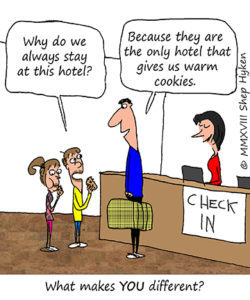 If you compete head-to-head with your competition, you may win or lose. If you compete by being different, you stand out. And, that’s a win.
If you compete head-to-head with your competition, you may win or lose. If you compete by being different, you stand out. And, that’s a win.
Over the years I’ve talked with many clients who are looking for ways to disrupt a competitor and/or win more business from existing customers. When we dig deep, I’ve found many clients are trying to compare themselves directly with their competitors. They want to make sure they offer at least what their competition is offering. It’s not that they’re trying to keep up. It’s that they are trying to not be outdone by their competition.
While I’m not excited about saying, “I want to be as good as them,” I’m willing to accept that this can at least be a starting point. The next step is to improve on whatever the competition is doing. I have written about this in the past. You can benchmark with your competition, but just use that as the starting point. And, more than just being better, can you offer something that the customer can’t get from the competitor. In other words, can you offer something that is different and makes you stand out?
Growing up we learned that different can be difficult. Different isn’t good. You’re taught that you want to fit in. But, in business, you want to be different – as long as what makes you different is something the customer wants and appreciates. You want to be known for something.
There are some great brands that are best known for one trait – that one trait that makes them different.
Volvo is known for safety. They are not known for high-speed performance cars, nor do they choose to compete in that world.
Huntington Bank differentiated themselves by extending the hours of operation. The recognized traditional hours were not convenient for the typical banking customer, so they extended their hours, staying open later during the week and being open on Saturdays.
Ace Hardware stores are not nearly as big as their big-box competitors. They separated themselves by promoting that they are smaller, which makes it easier for their customers to get in and get out. They also pride themselves on a different brand of customer service they refer to as “helpful service.”
Southwest Airlines is known for low fares, not charging for checked bags and no change fees. They are not known for having cushy first-class seats and meal service.
Jimmy John’s Gourmet Sandwiches is a typical sandwich shop that delivers, but what makes them different – and what they advertise – is how fast they deliver. In their words, they are Freaky Fast.
So, what makes you different? Is it obvious? Do your customers know about this big difference? Do they care about the difference? Answer those questions and you will be competing on another level – a different level!
Shep Hyken is a customer service expert, keynote speaker, and New York Times bestselling business author. For information, contact 314-692-2200 or www.hyken.com. For information on The Customer Focus customer service training programs, go to www.thecustomerfocus.com. Follow on Twitter: @Hyken
customer service training programs, go to www.thecustomerfocus.com. Follow on Twitter: @Hyken

(Copyright © MMXVIII, Shep Hyken)
The post Be Different appeared first on Shep Hyken.
December 11, 2018
Amazing Business Radio: Ty Collins

Transparency In Business
Delivering an Experience That Makes Price Irrelevant
Shep Hyken sits down with Ty Collins. They discussed how to raise your prices without losing customers, why you should be transparent, and how to give customers the best experience possible.








Top Takeaways:
Shep’s Opening Monologue:
In Shep’s opening monologue he answers the question, what is the difference between a loyalty program and a marketing program?
The Interview with Ty Collins:
In July 2018, a 25% import tariff forced Rad Power Bikes to increase their prices. Because they created a unique experience and were transparent with their customers about the price increase, this did not affect sales.
Rad Power Bikes decided to share their opinion about the trade tariffs publicly. This didn’t make every customer happy, but because they expressed their situation diplomatically, they were able to set the narrative and jump ahead of the issue.
Because their customer experience and tech support teams are so passionate and fired up about their industry, it wasn’t difficult for Rad Power Bikes to convey the correct message to their customers.
Ty likes to sit in with his customer experience team, answer customer emails, and listen to phone calls. No matter what your position is, everybody needs to spend a little time on the front line to hear the real voice of the customer.
Most of Rad Power Bike customers never see the bikes in person before making a purchase. It’s the CX team’s job to ease the customer’s concerns, build trust, and give them a memorable experience.
Providing good CX doesn’t mean always saying yes. There will be times when you have to make hard decisions and say things the customer isn’t going to want to hear at the moment.
Quotes:
“Customer service continues beyond the sale.” – Ty Collins
“Some of our greatest customer advocates are customers who’ve had issues that have been resolved. ” – Ty Collins
“You never have to remember your story if you’re telling the truth.” – Ty Collins
About:
Ty Collins is the Co-founder and CMO of Rad Power Bikes. He helped increase the company’s revenue to over $40M in just four years despite trade tariffs that forced him to raise his prices.
Shep Hyken is a customer service and experience expert, New York Times bestselling author, award-winning keynote speaker, and your host of Amazing Business Radio.
This episode of Amazing Business Radio with Shep Hyken answers the following questions … and more:
How do you retain customers?
How can you raise your prices without losing customers?
How can you build trust with future customers?
Does customer service change after the sale?
Do you always have to say “yes” to customers?
The post Amazing Business Radio: Ty Collins appeared first on Shep Hyken.
December 10, 2018
5 Top Customer Service Articles for the Week of December 10, 2018
Each week I read a number of customer service and customer experience articles from various resources. Here are my top five picks from last week. I have added my comment about each article and would like to hear what you think too.
Crazy Ideas About Customer Service You Would Like To Try Again by Guy Sheetrit
(Business 2 Community) Customer satisfaction is a great way to boost your business and if you have never considered it a priority, it is never too late to begin. If you also feel you have been getting it wrong all along, despite your efforts, you can always change the approach and try again.
My Comment: The title implies some of these customer service ideas are crazy. Maybe they are a little different and even “old school.” But, as the saying goes… everything old is new again. Try some of these ideas, old and new, and you may build an even better relationship with your customers. And, that’s not crazy at all!
How To Build A Brand: 14 Effective Strategies To Improve Customer Experience by Forbes Communications Council
(Forbes) It’s important to make that first impression count. But not all customer experience (CX) strategies are created equal. Which are the most effective for garnering positive audience attention and keeping it?
My Comment: The Forbes Communication Council has put together a list of 14 strategies that use CX to build a brand. This is a list that will make you think – and I’m sure will generate an idea or two to help your brand. My favorites are number five and eight, which both focus on employees.
What Entrepreneurs Can Learn From A Bad Customer Service Experience by Adam Mendler
(Forbes) My experience is far from unique: Customers get mistreated all the time in all kinds of ways. People who have no business working in customer-facing roles mishandle situations that are brought to their attention, and everyone loses. When one of your customers is dissatisfied, the only winner is your competitor.
My Comment: Here’s an interesting concept: Customers accept mistakes, not bad service. This is just one of three strong ideas in this article on how to avoid bad customer service. A short, but informative read.
7 Powerful Customer Service Phrases You Need to Use by Josh Carlyle
(Qminder) Here are 7 powerful customer service phrases that can support your interaction with customers.
My Comment: Sometimes good “old fashioned” customer service is all about the words we use. Phrases like “thank you” and “happy to help” seem like common sense, but every day I get messages on Facebook, Twitter, etc. from people who complain that simple things like a “thank you” seem to be less and less common. Whether that is the case or not, these phrases are sure to help customers feel appreciated and heard.
Startup right in 2019: how to set up your customer experience for success by Zendesk
(SmartCompany) For startup founders, passion for your business comes naturally. But customer service? Sometimes, not so much. While it is easy to obsess over every product or service feature, businesses need to prioritize building relationships with their customers from day one.
My Comment: 2019 is just around the corner, and maybe it’s time to re-focus some efforts on your customer service. Our friends at Zendesk have penned an article with several ideas that will help improve your CX. Here’s a good one: Know what makes your customers happy and what makes them angry. (Sometimes the obvious is not so obvious.)
Shep Hyken is a customer service expert, professional speaker and New York Times bestselling business author. For information on The Customer Focus customer service training programs go to www.TheCustomerFocus.com. Follow on Twitter: @Hyken
customer service training programs go to www.TheCustomerFocus.com. Follow on Twitter: @Hyken
The post 5 Top Customer Service Articles for the Week of December 10, 2018 appeared first on Shep Hyken.
December 7, 2018
Guest Blog: How Texting Has Become An Essential Customer Service Tool
This week we feature an article by Brian Elrod who discusses how texting has become an important customer service tool for any type of business. – Shep Hyken
Numbers show that customers enjoy text message communication. Here’s how some businesses are winning by texting.
A few years ago, my wife and I were trying to pay our bill at a restaurant after enjoying a meal with one of our sons. However, our server seemed to have disappeared just as we were ready to head home.
It was at that moment that my wife, Jamey, said something like, “Why can’t we just text them?” Her question served as a lightbulb moment for us, eventually turning into Text Request, the business texting service we co-founded in the fall of 2014.
Over the past four years, we’ve grown our business significantly, and we’re seeing our clients — from Harley-Davidson to the Ronald McDonald House — experience measurable wins by engaging their customers through texting.
But before we dive into some examples of texting successes, here are some notable statistics related to business texting:
18 — the percentage of emails that are read
5 — the percentage of phone calls that are answered
99 — the percentage of text messages that are read
90 — the average response time, in seconds, for text messages
89 — the percentage of consumers who want messaging conversations with businesses
I could go on and on with more texting data, but you probably understand what I’m driving at already — that texting is statistically proven to be an effective communication channel that customers actually like.
Don’t get me wrong, I’m not suggesting you drop every other customer communication channel you’ve got. But given the statistics above and the examples below, what I am
suggesting is that you might be able to secure some serious customer service wins via text.
Now, for those examples.
Pure Barre
We work with Tiffany Jodice, a Pure Barre franchise owner in Tennessee, who uses texting in numerous ways to engage her clients. While the channel gives her a direct opportunity to keep everyone up to speed about the status of their packages (e.g. how many classes they have left),
it also allows two-way conversations so clients can notify their instructor if they’re running late or need any special accommodations.
Through text, the Pure Barre franchisee is able to increase package renewals, manage class attendance, and strengthen client relationships.
LGC Hospitality Staffing
If you have staffing needs in the U.S. hospitality industry, you’ve likely heard of LGC Hospitality Staffing. Through text messaging, our partner, Jaime Horning, has streamlined the typically cumbersome task of vetting job applicants and filling vacant positions.
One exciting experience they had recently, thanks to texting, was when they were able to fill every job for a Portland Timbers (MLS) season-opening match in just four hours. They told us that normally would take four to five days. Yes, days!
Scenic City Orthodontics
A consistent struggle across the healthcare community is appointment no-shows. Our friends at Scenic City Orthodontics are no strangers to this reality, but since leveraging texting they’ve been able to fill holes in their calendars quickly, avoiding empty patient slots.
According to office manager Tasha Mattila, patients feel more comfortable texting, they respond to messages almost immediately and rarely do they opt out of the service. Tasha also says texting is a huge help in communicating with patients who don’t speak English as a first language.
As was the case when I was rattling off texting statistics earlier, I could offer a long list of testimonials. But again, you get the point by now — it might be time to consider ways you could use texting to engage your customers.
One of the best things about texting is that it’s not beholden to a single industry. Whatever your product or service is, and whoever your audience might be, there is a good chance (a very good chance) your customer engagement will benefit from trying out text.
Brian Elrod is a co-founder of Text Request, a business texting service.
For more articles from Shep Hyken and his guest contributors go to customerserviceblog.com.

Read Shep’s latest Forbes article: Give A Valuable Gift: The Top 10 Business Books For 2018
The post Guest Blog: How Texting Has Become An Essential Customer Service Tool appeared first on Shep Hyken.
December 5, 2018
What Causes Friction
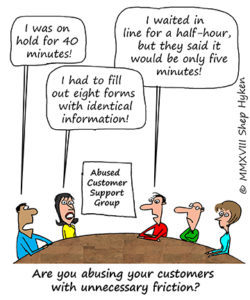 In the past few months leading up to my new book, The Convenience Revolution, I’ve focused on ways to be more convenient for your customers. I’ve shared six Convenience Principles and numerous examples and case studies. The goal is to eliminate friction. What I haven’t done is talked to you about what causes friction.
In the past few months leading up to my new book, The Convenience Revolution, I’ve focused on ways to be more convenient for your customers. I’ve shared six Convenience Principles and numerous examples and case studies. The goal is to eliminate friction. What I haven’t done is talked to you about what causes friction.
Here’s a question: What is it that you don’t like about some of the companies and organizations you do business with? As an example, there is always a company that makes me go through their entire advertising pitch before anyone picks up the phone. I’ve practically memorized it. It’s frustrating that I am forced to listen to that recording every time I call. That’s friction.
Here are TEN WAYS companies (and employees) create friction. These are the “convenience infractions” that potentially drive away customers.
Bad policies: I hate when someone does something that seems like a waste of time, and then blames it on a policy or gives me a negative response to a question and says, “It’s company policy.”
Duplicate paperwork: I’m always amazed at the amount of duplicate paperwork that is filled out. I recently talked to an executive of a bank, and he mentioned it was a big problem.
Cumbersome technology: Hard-to-navigate websites drive away customers.
Broken anything: If something is broken, the moment you find out about it, start fixing it. I’m surprised at what isn’t fixed in a reasonable period of time.
Making customers wait: Sometimes a wait is inevitable. However, if you make a customer wait, let them know how long. Then don’t be late!
Inconsistent information: When a customer gets two or more different answers to the same question, what pain do you cause their brain? Confusion is friction.
Poorly trained employees: It can tie into inconsistent information, but it’s more than that. Employees that demonstrate a lack of knowledge or competency frustrates customers. Frustration is friction.
Not being able to talk to a person: This is also frustrating. Some companies make it hard to get to a person. If a customer is on a website and needs help, there should always be a human fallback.
A bad customer experience design: The concept of CX design is a hot topic. Companies are assigning executive titles to the person in charge of “design.” This isn’t designing labels and packaging. This is designing the total end-to-end experience the customer has with your company. This is the person in charge of eliminating friction!
Anything that wastes a customer’s time: This is more than putting a customer on a long hold. When it comes to business, the opposite of friction is easy, as inconvenient. Much of convenience is not just being easy, but also saving the customer time. Anything that doesn’t save the customer time, or wastes their valuable time, is friction.
This isn’t meant to be a rant. It’s simply a list of some of the ways companies frustrate their customers and cause friction. And, it’s a partial list. There are other ways companies cause friction for their customers – and even their employees. Now it’s time to ask yourself the tough question: Am I guilty of any of these convenience infractions?
Shep Hyken is a customer service expert, keynote speaker, and New York Times bestselling business author. For information, contact 314-692-2200 or www.hyken.com. For information on The Customer Focus customer service training programs, go to www.thecustomerfocus.com. Follow on Twitter: @Hyken
customer service training programs, go to www.thecustomerfocus.com. Follow on Twitter: @Hyken

(Copyright © MMXVIII, Shep Hyken)
The post What Causes Friction appeared first on Shep Hyken.



